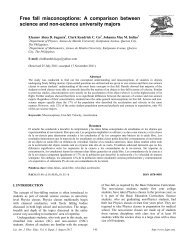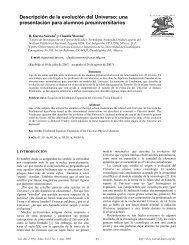Physics by Simulation: Teaching Circular Motion using Applets
Physics by Simulation: Teaching Circular Motion using Applets
Physics by Simulation: Teaching Circular Motion using Applets
You also want an ePaper? Increase the reach of your titles
YUMPU automatically turns print PDFs into web optimized ePapers that Google loves.
Vasudeva Rao Aravind and John W. Heard<br />
student learning from the simulation. We then evaluate the<br />
effectiveness of the simulation and lecture combination <strong>by</strong><br />
asking the students to solve a conceptual problem (Section<br />
V). We finally conclude <strong>by</strong> analyzing the students’ solution<br />
to this problem statistically and show that this teaching<br />
method was indeed effective (Section VI).<br />
II. STUDENT SAMPLE<br />
The sample for this study included 49 students at Clarion<br />
University, Clarion, Pennsylvania. The students belonged to<br />
the class of PHY 251 (General <strong>Physics</strong>) course offered <strong>by</strong><br />
Clarion University. This student group consists of people<br />
from various backgrounds such as chemistry, biology,<br />
geology, etc. (none of the students have had any other<br />
physics courses beyond high school). The class level of<br />
students ranged from freshman to senior undergraduate<br />
level.<br />
A. Student preparation<br />
Prior to working on this simulation, the students had taken a<br />
series of lectures covering introductory physics topics:<br />
Newton’s laws of motion (equilibrium and non-equilibrium<br />
applications), the Normal Force and Gravitational Force,<br />
Static and frictional forces and Uniform circular motion<br />
(covering centripetal acceleration and centripetal force).<br />
The textbook followed for this course was “<strong>Physics</strong>” <strong>by</strong><br />
Cutnell and Johnson [10]. These lectures were arranged to<br />
teach them how to draw free body force diagrams.<br />
III. SIMULATION<br />
The students were asked to visit the website<br />
http://www.mhhe.com/physsci/physical/giambattista/banke<br />
d_curve/banked_curve.html. This web based freely<br />
available simulation published <strong>by</strong> McGraw-Hill<br />
publications on circular motion enables to students to<br />
explore the role of frictional force in the motion of a race<br />
car traveling down a banked circular road. A screen shot for<br />
this simulation is given below.<br />
The students are asked to set the track incline (banking<br />
o<br />
angle) to a constant value of 20 and keep varying the<br />
speed (they start at a speed of 0 m/s and keep on increasing<br />
the speed <strong>by</strong> 1 m/s) and observe the speed at which the car<br />
crashes. The students were asked to make a table (Table I)<br />
In Table I, the cases corresponding to μ =1.5, 1.2, 0.9<br />
and 0.6 are straightforward. Lesser frictional force supports<br />
lesser speed in the centripetal term ( mv<br />
2 / r , where m is<br />
the mass of the car, v is its speed and r is the radius of the<br />
circle) and hence cars have to travel slower to avoid a crash.<br />
FIGURE 1. Screen shot of the simulation representing race car<br />
running on a circular track. The right side of the image shows the<br />
set parameters for this simulation.<br />
TABLE I. Evaluation question handed out to students to evaluate<br />
their understanding of physical concepts from simulation shown in<br />
Figure 1.<br />
Coefficient of friction, μ<br />
1.5<br />
1.2<br />
0.9<br />
0.6<br />
0.3<br />
Speed at which<br />
car crashes (m/s)<br />
However the coefficient of frictional force corresponding to<br />
μ =0.3 can be a little bit tricky. For this case, if the students<br />
start with a zero velocity, the car simply runs to the bottom<br />
of the incline, as the net force toward the center is greater<br />
than mv<br />
2 / r , the centripetal term. On the other hand, if one<br />
starts the car with a greater speed, the centripetal term<br />
mv<br />
2 / r is enough to balance the combined effect of the<br />
component of the car’s weight acting down the incline as<br />
well as the frictional force (which acts towards the bottom<br />
of the incline in this case). If the speed is further increased,<br />
in this case beyond 38 m/s, the centripetal force outweighs<br />
the opposing forces and the car crashes towards the top of<br />
the incline. As shown in the data analysis in the next<br />
section, only some students could recognize this fact.<br />
IV. SIMULATION DATA ANALYSIS<br />
In order to evaluate student understanding of the physical<br />
concepts, we analyzed the table (Table I) completed <strong>by</strong> the<br />
students. The pie chart shown in figure 2 summarizes the<br />
answers to table 0 <strong>by</strong> the students.<br />
We see that only 10.6% of the students recognized that<br />
there are two limits to the speed of the car as it moves on<br />
the inclined track, namely 0 m/s and 38 m/s. We decided to<br />
Lat. Am. J. Phys. Educ. Vol. 4, No. 1, Jan. 2010 36 http://www.journal.lapen.org.mx



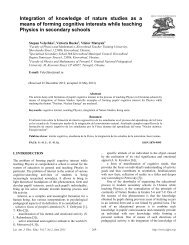
![Diversas formas de visualizar estados en un sistema cuántico [PDF]](https://img.yumpu.com/51151303/1/190x245/diversas-formas-de-visualizar-estados-en-un-sistema-cuantico-pdf.jpg?quality=85)

![Precession and nutation visualized [PDF]](https://img.yumpu.com/50786044/1/190x245/precession-and-nutation-visualized-pdf.jpg?quality=85)
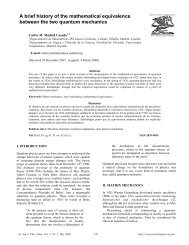
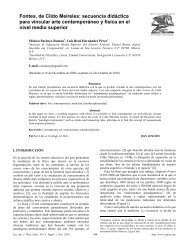
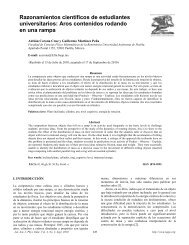

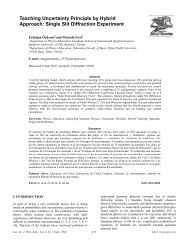
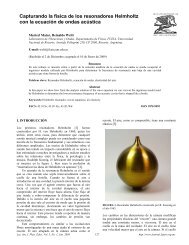
![Index [PDF] - Latin-American Journal of Physics Education](https://img.yumpu.com/47984121/1/190x245/index-pdf-latin-american-journal-of-physics-education.jpg?quality=85)
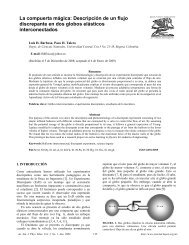
![Flujo de agua en botellas como experimento didáctico [PDF]](https://img.yumpu.com/43536300/1/190x245/flujo-de-agua-en-botellas-como-experimento-didactico-pdf.jpg?quality=85)
